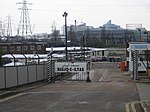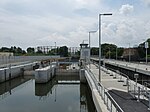Lee Tunnel
The Lee Tunnel, also known as the Stratford to East Ham deep tunnel, is a paradigm overflow sewer in East London for storage and conveyance of foul sewage mixed with rainwater. It was built as part of the Thames Tideway Scheme and runs from Abbey Mills Pumping Station down to pumps and storage tanks at Jenkins Lane, Beckton Sewage Treatment Works. It is wholly under the London Borough of Newham. This 6.9 km (4.3 mi) tunnel, of 7.2 m (24 ft) diameter, laid at between 75 m (246 ft) deep, at start, to 80 m (260 ft) at finish, captures c. 16,000,000 m3 (1.6×1010 L), or 16 million tonnes, of sewage annually from the single largest polluting CSO in London - the amount varies with rainfall. This sewage overflow had flowed untreated into the River Lea, after which it diluted gradually in the Thames Tideway (the narrowest parts of the Thames Estuary). It can take 30 days for effluent to reach the sea from the Tideway.From its terminus, pumps send the effluent into the adjacent Beckton Sewage Treatment Works – the largest such works in Europe. From that works the resultant water (treated sewage), with solids removed and the most harmful chemicals treated, empties into the (Thames's) Tideway, its upper estuary. Lying at −75 metres (−246 ft) AOD means a second source of London's old-style combined sewers' effluent can be caught, that from the Thames Tideway Tunnel, which is under construction and due to open in 2024.
Excerpt from the Wikipedia article Lee Tunnel (License: CC BY-SA 3.0, Authors).Lee Tunnel
Long Wall, London West Ham (London Borough of Newham)
Geographical coordinates (GPS) Address Nearby Places Show on map
Geographical coordinates (GPS)
| Latitude | Longitude |
|---|---|
| N 51.5307 ° | E -0.000835 ° |
Address
Abbey Mills Pumping Station
Long Wall
E3 3JL London, West Ham (London Borough of Newham)
England, United Kingdom
Open on Google Maps







